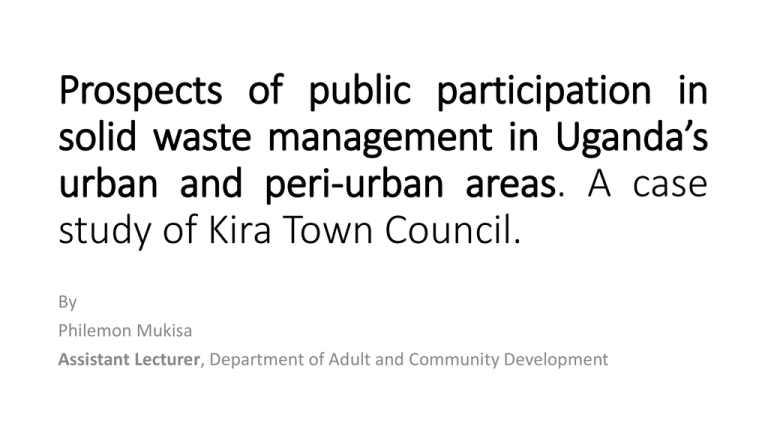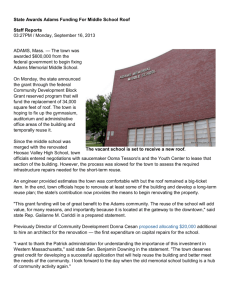Public_participation_in_Solid_Waste_Mgt.ppt
advertisement

Prospects of public participation in solid waste management in Uganda’s urban and peri-urban areas. A case study of Kira Town Council. By Philemon Mukisa Assistant Lecturer, Department of Adult and Community Development INTRODUCTION • Solid waste disposal and management is both an urban and rural problem. • The rate at which solid waste is generated is far higher than the capacity to responsibly manage this waste. • Waste volumes have increased in urban areas due to the growing population, concentration of industries, consumption of residents, and inadequate finance and facilities to manage waste collection and disposal (NEMA 2007:276). • There is growing consensus that the immediate stakeholders in the issue of solid waste (the generators of waste), need to join hands with the authorities in dealing with this problem that has far-reaching environmental and human health effects. Scope • Main objective of the study was to explore the level of public participation in solid waste management in Kira Town Council Specific areas of concern • To establish the role that the public plays in solid waste management in Kira Town Council • To find out what more the public thought they could do apart from what they were already doing, for better solid waste management in the future Theoretical base Participation could start with just face-value collaboration and it turns out to be complementarity, into embeddedness (Evans, 1996) and could end up into a coproductive structure (Ostrom, 1996). Good public participation programs are inclusive; they avoid a monologue and emphasize dialogue which becomes instrumental in contributing to success (USEPA, 1996). Methodology • The study used descriptive survey design drawing on the cross-sectional study design as explained by Bryman (2004) and also on aspects of a phenomenological research design as discussed by Blanche et al., (2006). • 3 (Kirinya, Kireka and Kyaliwajala) out of the 6 were selected by simple random sampling method. • 101 rparticipants (from the public) were conveniently sampled and interviewed by structured interview method. • 30 other participants were interviewed by semi-structured interview and at the same time observed. • 3 focus groups were held, with private-individual solid waste collectors/service providers. • 2 officials from the Town council interviewed by semi-structured interview. Key Findings What the public was doing • Use of waste containers- traders used containers more than households, with variations among the wards • Waste sorting- 55.4% of the respondents confessed not doing any basic waste sorting. There was no significant colleration btn level of education and waste sorting. • Several items were reused- banana peelings, plastic tins and bottles, old cloth, basins etc Prospects • 81.2% of the participants view felt that it was not possible for them to reduce on the amount of waste they generated • 46.5% could identify some items that are discarded of as waste but could be reused (metals, empty sacks, plastic tins, polythene bags, empty plastic mineral water bottles, paper boxes and empty cooking oil jerry cans) • 89.1% of the participants felt that it is helpful to sort waste at the source (Plastics was the most popular item that needed to separate) • 78.2% of the participants were willing to pay waste collection fees if introduced in future • 87.1% of the participants expressed openness and willingness to work with others on solid waste management. Discussion • Innovativeness of the people in keeping the solid waste in one place before disposal using different materials. • Sorting of solid waste was less adopted. Many of those who said they sorted their waste had already declared that they did not possess waste containers • People do not deliberately reuse items in order to reduce the solid waste volume but are rather pushed to reuse because they do not have much choice. • The people themselves and the private service providers (whether individual or firms) played the biggest role in solid waste management. • The public seemed to be ready to pay the bill for their waste though the authorities were still hesitant to introduce them Recommendations • Public to be involved in planning for waste management as first step • Sensitization of the public on waste reduction, reuse, recycling and composting before disposing • Introduction of fees and privatisation of the service to start with dialoguing between the public and the authorities




